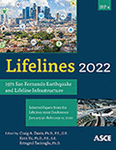Using Global Variance-Based Sensitivity Analysis to Prioritize Bridge Retrofits for Low-Probability, High-Cost Earthquakes
Publication: Lifelines 2022
ABSTRACT
We propose a global sensitivity-analysis-based method for prioritising bridge seismic retrofits in a regional road network with respect to the pth percentile of the road network performance cost (Pp) over a set of disruptive earthquake scenarios. This modifies a previous method that considered the expected cost of the road network performance. The pth percentile of the road network performance cost captures the costly consequences of low-probability earthquakes. We estimate bridges’ total-order sensitivity (Sobol’) indices with respect to Pp using the hybrid-point Monte Carlo approximation method. We show that retrofitting bridges in decreasing order of their total-order Sobol’ indices reduces P99.9 more efficiently than other heuristic strategies on a network of B = 71 unique bridges in San Francisco. This method leverages existing risk assessment tools and remains computationally tractable while accounting for the probabilistic nature of the seismic hazard, the uniqueness of individual bridges, and network effects.
Get full access to this article
View all available purchase options and get full access to this chapter.
REFERENCES
Barbarasoglu, G., and Arda, Y. (2004). “A two-stage stochastic programming framework for transportation planning in disaster response.” Journal of the Operational Research Society, 55: 43–53.
Bhattacharjee, G., and Baker, J. W. (2021). “Using global variance-based sensitivity analysis to prioritize bridge retrofits in a regional road network subject to seismic hazard.” Structure and Infrastructure Engineering (in press). https://doi.org/10.1080/15732479.2021.1931892
Borgonovo, E., and Plischke, E. (2016). “Sensitivity analysis: A review of recent advances.” European Journal of Operational Research, 248(3): 869–87. https://doi.org/10.1016/j.ejor.2015.06.032.
Buckle, I. G. (1994). “The Northridge California earthquake of January 17, 1994: Performance of Highway Bridges.” National Center for Earthquake Engineering Research. https://mceer.buffalo.edu/pdf/report/94-0008.pdf.
Buckle, I. G., Friedland, I., Mander, J., Martin, G., Nutt, R., and Power, M. (2006). Seismic Retrofitting Manual for Highway Structures: Part 1 - Bridges. Multidisciplinary Center for Earthquake Engineering Research.
Chang, L., Peng, F., Ouyang, Y., Elnashai, A. S., and Spencer, B. F., Jr. (2012). “Bridge Seismic Retrofit Program Planning to Maximize Postearthquake Transportation Network Capacity.” Structure and Infrastructure Engineering, 18: 75–88.
Dong, Y., Frangopol, D. M., and Saydam, D. (2014). “Pre-Earthquake Multi-Objective Probabilistic Retrofit Optimization of Bridge Networks Based on Sustainability.” Journal of Bridge Engineering, 19(6): 04014018.
Dutuit, Y., and Rauzy, A. (2015). “On the extension of Importance Measures to complex components.” Reliability Engineering and System Safety, 142: 161–168. https://doi.org/10.1016/j.ress.2015.04.016.
Fan, Y., Liu, C., Lee, R., and Kiremidjian, A. S. (2010). “Highway Network Retrofit under Seismic Hazard.” Journal of Infrastructure Systems, 16(3): 181–187.
Giovinazzi, S., Wilson, T., Davis, C., Bristow, D., Gallagher, M., Schofield, A., Villemure, M., Eidinger, J., and Tang, A. (2011). “Lifelines performance and management following the 22 February 2011 Christchurch earthquake, New Zealand: Highlights of resilience.” Bulletin of the New Zealand Society for Earthquake Engineering, 44(4): 402–417. https://doi.org/10.5459/bnzsee.44.4.402-417.
Gomez, C., and Baker, J. W. (2019). “An optimization-based decision support framework for coupled pre- and post-earthquake infrastructure risk management.” Structural Safety, 77, 1–9. https://doi.org/10.1016/j.strusafe.2018.10.002.
Grass, E., and Fischer, K. (2016). “Two-stage stochastic programming in disaster management: A literature survey.” Surveys in Operations Research and Management Science, 21(2): 85–100. https://doi.org/10.1016/j.sorms.2016.11.002.
Hackl, J., Adey, B. T., and Lethanh, N. (2018). “Determination of Near-Optimal Restoration Programs for Transportation Networks Following Natural Hazard Events Using Simulated Annealing.” Computer-Aided Civil and Infrastructure Engineering, 33(8): 618–637. https://doi.org/10.1111/mice.12346.
Han, Y., and Davidson, R. A. (2012). “Probabilistic seismic hazard analysis for spatially distributed infrastructure.” Earthquake Engineering & Structural Dynamics, 41: 2141–2158.
Kiremidjian, A. S., Stergiou, E., and Lee, R. (2007). “Issues in seismic risk assessment of transportation networks.” In Geotechnical, Geological and Earthquake Engineering, 6: 461–480. https://doi.org/10.1007/978-1-4020-5893-6_19.
Liu, C., Fan, Y., and Ordóñez, F. (2009). “A two-stage stochastic programming model for transportation network protection.” Computers and Operations Research, 36(5): 1582–1590. https://doi.org/10.1016/j.cor.2008.03.001.
Liu, M., and Frangopol, D. M. (2006). “Optimizing Bridge Network Maintenance Management under Uncertainty with Conflicting Criteria: Life-Cycle Maintenance, Failure, and User Costs.” Journal of Structural Engineering, 132(11): 1835–45. https://doi.org/10.1061/(ASCE)0733-9445(2006)132:11(1835).
Miller, M. (2014). Seismic risk assessment of complex transportation networks. PhD thesis, Stanford University. http://purl.stanford.edu/gg691nz8534.
Miller, M., and Baker, J. W. (2013). “Ground-motion intensity and damage map selection for probabilistic infrastructure network risk assessment using optimization.” Earthquake Engineering and Structural Dynamics, 44(7): 1139–1156.
Miller-Hooks, E., Zhang, X., and Faturechi, R. (2012). “Measuring and maximizing resilience of freight transportation networks.” Computers and Operations Research, 39(7): 1633–1643. https://doi.org/10.1016/j.cor.2011.09.017.
Padgett, J. E., and DesRoches, R. (2009). “Retrofitted bridge fragility analysis for typical classes of multispan bridges.” Earthquake Spectra, 25(1): 117–141. https://doi.org/10.1193/1.3049405.
Peeta, S., Salman, F. S., Gunnec, D., and Viswanath, K. (2010). “Pre-disaster investment decisions for strengthening a highway network.” Computers and Operations Research, 37(10): 1708–1719. https://doi.org/10.1016/j.cor.2009.12.006.
FHWA (Federal Highway Administration). (1995). Recording and Coding Guide for the Structure Inventory and Appraisal of the Nation’s Bridges. Washington, D.C.: US Department of Transportation.
Rokneddin, K. (2013). Reliability and risk assessment of networked urban infrastructure systems under natural hazards. PhD thesis, Rice University.
Rokneddin, K., Ghosh, J., Dueñas-Osorio, L., and Padgett, J. E. (2013). “Bridge retrofit prioritisation for ageing transportation networks subject to seismic hazards.” Structure and Infrastructure Engineering, 9(10): 1050–1066. https://doi.org/10.1080/15732479.2011.654230.
Saltelli, A., Tarantola, S., Campolongo, F., and Ratto, M. (2004). Sensitivity Analysis in Practice: A Guide to Assessing Scientific Models. Vol. 101. 473. John Wiley; Sons, Ltd.
Shinozuka, M., Murachi, Y., Dong, X., Zhou, Y., and Orlikowski, M. J. (2003). “Effect of seismic retrofit of bridges on transportation networks.” Earthquake Engineering and Engineering Vibration, 2(2): 169–179.
Sobol, I. M. (1993). “Sensitivity estimates for nonlinear mathematical models.” Mathematical Modelling and Computational Experiments, 1: 407–414.
Information & Authors
Information
Published In
History
Published online: Nov 16, 2022
Authors
Metrics & Citations
Metrics
Citations
Download citation
If you have the appropriate software installed, you can download article citation data to the citation manager of your choice. Simply select your manager software from the list below and click Download.
